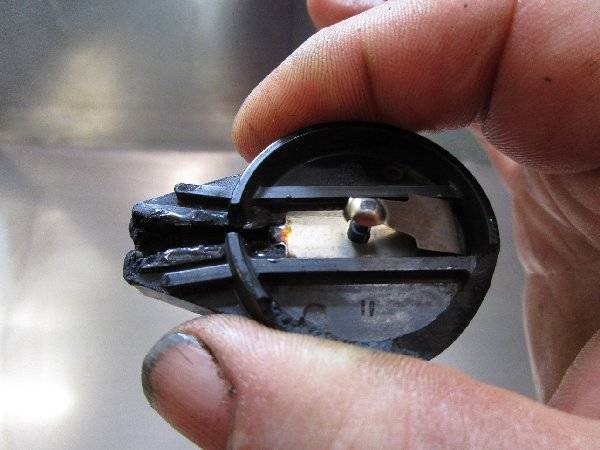|
Re: Pointedly sluggish
|
||||
|---|---|---|---|---|
|
Home away from home
|
Related, but unrelated. The object in the picture is a standard Delco Remy distributor rotor such as used on 53-58 Packards. You might wonder where the resistor and the contact have gone.
Drove my '56 President down Baltimore to take my 89 year old aunt shopping. Car was a little fussy to restart at the grocery store but I attributed that to the heat. On the way home I am flying up the hill on the interstate coming up from the river when the car completely loses power without so much as a burp and I coast to a stop on the shoulder. No luck on a restart and there is plenty of fuel reaching the carb in spite of the heat. Was lucky to reach my friend who towed me home behind the '56 Packup on the end of a rope. The public loved it. Looked in the distributor this morning when temperatures and tempers were cooler to discover this. Frankly I thought I had cleared the property of these odious rotors, but I had missed this one. It had done what they all too often do which is self destruct. Replaced it with the non-resistor concurrent Pontiac rotor (Napa RR157) and all was right with the world. Suggest you do the same if you have 53-58 Delco equipment in your Packard.
Posted on: 2018/9/7 20:46
|
|||
|
||||
|
Re: Pointedly sluggish
|
||||
|---|---|---|---|---|
|
Home away from home
|
Wow! I never saw a rotor do that. My notes show a different Napa non-resistor rotor (RR159) - do you know what the difference is?
As for the sluggishness, my 1952 Henney-Packard would run well but one time trying to move it in the yard I could hardly get its 6,200 lb weight moving but it proved to be more serious than your fix: the petrol was on the verge of going bad! I ran it up to temperature one Saturday and managed to move it but the next Saturday it wouldn't crank as if the engine were stuck which it was due to all the buildup on the valves. One even bent trying to remove it.
Posted on: 2018/9/8 11:25
|
|||
|
All generalities are false.
Once I thought I was wrong but I was mistaken. Don Pierson Packard / IMPERIAL page CA DMV Licensed Vehicle VIN Verification 1951 Henney-Packard 3-Door Long Wheelbase Air Force Ambulance The 1951 Henney-Packard is For Sale! 1954 Packard Patrician 1954 Packard Patrician Parts Car 1956 Clipper Custom Sedan |
||||
|
||||
|
Re: Pointedly sluggish
|
||||
|---|---|---|---|---|
|
Home away from home
|
I don't like disagreeing with expert Ross, I buy his solution, points & condenser bad) but not necessarily the "explanation".
Maybe just semantics. One of the functions of the condenser is to prevent jumping or "premature" or too many sparks. ie only spark while contacts are closed. If the dwell angle is low, that's supposed to mean, the contacts are engaged/closed/sparking for a lesser amount of time which could be a sign the spark is jumping early, ie, it's acting like the timing is off, maybe due to faulty condenser. But it's also a function of how it's measured electrically. If it's all functioning, then the contact gap controls the dwell typically. AKA adjusting the points via feeler or dwell method. If points couldn't keep up with the rpms, like a weak spring issue, worn follower, or resistive/inductive bounce, I'd suspect the dwell signal would be noisy/jumpy not just low? Maybe was not noted? Analog dwell meters have a bit of indicator damper so it maybe the device response. That's how they(Kettering) discovered the need for a capacitance in the spark circuit in the first place, if I recall. The points life is reduced when the condenser is bad. Nothing to do during a hurricane but contemplate dwell??? I'm sure HH or Ross will correct me or others have an opinion.
Posted on: 2018/9/13 19:09
|
|||
|
||||

 (105.41 KB)
(105.41 KB)







